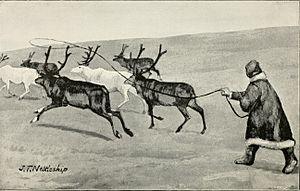Reindeer warble fly facts for kids
Quick facts for kids Reindeer warble fly |
|
|---|---|
 |
|
| Scientific classification | |
| Genus: |
Hypoderma (fly)
|
| Species: |
tarandi
|
| Synonyms | |
|
Oedemagena tarandi |
|
The Hypoderma tarandi, also known as the reindeer warble fly or reindeer botfly, is a type of warble fly. It is a parasite that lives on reindeer. This means it lives on or in another animal, called a host, and gets its food from the host, often harming it.
The young forms of this fly, called larvae or maggots, live under the skin of reindeer and caribou. They are found mostly in Arctic areas. These larvae can cause problems for reindeer herds that are raised by people. They can damage the animals' hides (skins), meat, and even affect milk production.
Sometimes, these flies can also affect humans. If the larvae get into a person's eye, it can cause eye problems like swelling or damage to vision. Other similar flies, like H. lineatum and H. sinense, can also infest humans.
Reindeer Warble Fly as Food
In very cold places where people rely on reindeer or caribou for food, the maggots of the Hypoderma tarandi fly are sometimes eaten. This happens when the animals are prepared for food.
The larvae of Hypoderma tarandi were a traditional food for the Nunamiut people. There is also old art from the Pleistocene era in Europe that shows these larvae were eaten long ago.
In an episode of the TV show Beyond Survival, survival expert Les Stroud and two Inuit guides hunted caribou. When they prepared the animal, they found many larvae inside its skin. Stroud and the guides each ate one larva. Stroud said it "tastes like milk" and that the Inuit people often ate them in the past.
See also
 In Spanish: Hypoderma tarandi para niños
In Spanish: Hypoderma tarandi para niños


